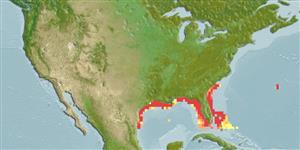分类 / Names
俗名 | 同种异名 | Catalog of Fishes(属, 种) | ITIS | CoL | WoRMS | Cloffa
Teleostei >
Blenniiformes (Blennies) >
Dactyloscopidae (Sand stargazers)
Etymology: Dactyloscopus: Greek, daktylos = finger + Greek, skopein = to look (Ref. 45335).
Eponymy: Clarence Bloomfield Moore (1852–1936) was an American archaeologist, particularly noted for his studies of Native American sites. [...] (Ref. 128868), visit book page.
More on author: Fowler.
Environment: milieu / climate zone / depth range / distribution range
生态学
海洋 居于水底的; 深度上下限 3 - 35 m (Ref. 27742). 亞熱帶的; 33°N - 24°N
Western Central Atlantic: North Carolina to Florida Keys and Texas in the Gulf of Mexico.
中西大西洋: 在墨西哥灣的北卡羅萊那州到佛羅里達珊瑚礁與德克薩斯。
大小 / 重量 / 年龄
Maturity: Lm ? range ? - ? cm
Max length : 8.0 cm TL 雄鱼/尚未辨别雌雄; (Ref. 7251)
简单描述
检索表 | 型态特徵 | 形态测量图
背棘 (总数) : 11 - 13; 臀棘: 2; 臀鳍软条: 30 - 35. Common amongst Dactyloscopidae: Small, elongate fishes. Head usually broad and deep, body tapering and compressed behind. Eyes on top of head, often protrusible; mouth moderate to large, oblique to vertical; upper and/or lower lips with fimbriae; jaw teeth minute, in 2 or more series; no teeth on roof of mouth (vomer and palatines). Opercular opening large, gill membrane free from isthmus; opercles membranous, large, usually overlapping on underside of head, typically fringed above with 2 to 24 fleshy fimbriae. Dorsal fin continuous, with an isolated or semi-isolated anterior finlet, or with 1 to 5 separate anterior rays; dorsal-fin spines 7 to 23; anal-fin spines 2; dorsal and anal fins free or united to caudal fin by fragile membranes; pectoral fins broad-based, usually enlarged in mature males; caudal-fin rays simple or branched; pelvic fins under throat (insertion anterior to pectoral-fin base), with 1 spine and 3 thickened segmented rays; all other rays simple. Head and venter naked, body elsewhere with large cycloid scales (smooth to touch); lateral line high anteriorly, deflecting ventrally behind pectoral fin to continue along middle of side to caudal-fin base where terminal lateral-line scale bears ventrally directed canal. Body coloration, variably pale to strongly pigmented with white, brown, or reddish; some forms with characteristic saddle-like bars crossing back; others plain, mottled, or with indications of lateral stripes. Species distinguished by: dorsal-fin origin on nape; without a distinct anterior finlet; dorsal-fin spines usually 11 to 13. Segmented anal-fin rays 30 to 35 (usually 31 to 34). First preopercular canal branched, with 2 or more distal pores. Posterior naris (a single pore) located on anterior rim of preorbital, adjacent to base of tubiform anterior naris; premaxillary pedicels reach well past rear margins of orbits. Expanded eyestalk not exceptionally long and slender. Eye without a distal ring of translucent spots or dermal flaps. Upper lip fimbriae usually 13 to 17. Two to 4 rows of scales on each side of nape anterior to first dorsal-fin spine base (midline of nape naked) (Ref.52855).
Burrows in soft sandy bottom, where it waits for prey, with only the eyes, nose and mouth protruding.
穴居在软的沙质底部中, 在哪里它等候猎物, 只有眼, 鼻子与嘴伸出。
Life cycle and mating behavior
成熟度 | 繁殖 | 产卵场 | 卵 | 孕卵数 | 仔鱼
中西大西洋: 在墨西哥灣的北卡羅萊那州到佛羅里達珊瑚礁與德克薩斯。
Dawson, C.E., 1982. Atlantic sand stargazers (Pisces: Dactyloscopidae), with description of one new genus and seven new species. Bull. Mar. Sci. 32(1):14-85. (Ref. 27742)
世界自然保护联盟红皮书 (Ref. 130435: Version 2024-2)
人类利用
渔业:
工具
特别资料
下载 XML
网络资源
Estimates based on models
Preferred temperature (Ref.
123201): 23.4 - 26.5, mean 24.1 °C (based on 100 cells).
Phylogenetic diversity index (Ref.
82804): PD
50 = 0.5000 [Uniqueness, from 0.5 = low to 2.0 = high].
Bayesian length-weight: a=0.00389 (0.00180 - 0.00842), b=3.12 (2.94 - 3.30), in cm total length, based on all LWR estimates for this body shape (Ref.
93245).
营养阶层 (Ref.
69278): 4.3 ±0.6 se; based on size and trophs of closest relatives
Fishing Vulnerability (Ref.
59153): Low vulnerability (10 of 100).
